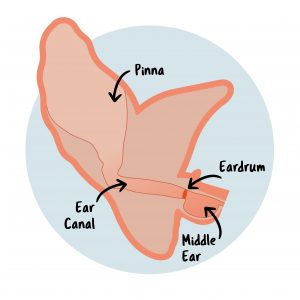Applying ear drops to your dog can be a daunting task for any pet owner. However, with the proper knowledge and technique, administering ear drops to your furry friend can be a simple and stress-free process.
In this guide, our very own vet, Victoria, will walk you through the proper way to apply ear drops to your dog. This includes how to properly clean the ear, the best way to administer the medication, and how to monitor your dog’s recovery. With the right approach and care, you can ensure that your dog receives the treatment they need to maintain its ear health. So, let’s get started!
Before application
In preparation for treating your dog, you should always aim to apply medicated drops to a clean ear. Watch our video above on how to clean your dog’s ears before applying any drops.
It’s important to consider that your dog may be in some pain or discomfort with its ear and might not respond well to you cleaning/treating the area. Even the calmest, gentle, and most passive dog may react with a struggle, bark, growl, or even bite. To avoid this, be cautious and patient with your dog. For particularly reactive or anxious dogs, you may find it useful to apply a muzzle before the procedure for added safety.
How to easily apply ear drops to your dog
- Wait 15 minutes after cleaning your dog’s ears before you begin applying the medicated ear drops.
- Check the medication label, including the dose and frequency of application. The instruction sheet supplied with the drops will give you advice on how to use that particular ear treatment.
- Make sure that your dog is in a comfortable position. If you have a small dog, positioning them on your lap is a good idea. Otherwise, laying them down on a flat surface or sitting them in front of you can make applying ear drops easier.
- Prepare the medication according to the instructions that accompany the bottle. You can roll the bottle in your hand to warm up the liquid beforehand so that it’s not as cold before applying it to the ear.
- Whilst holding the pointy end of the ear up, you can introduce the nozzle of the bottle/pipette to the ear canal and carefully begin to apply the number of drops stated on the label. Sometimes it can be difficult to know how much pressure to apply to form a drop, so it can be useful to practice on a piece of kitchen roll first if you are unsure.
- Once the drops are applied, you can gently massage around the base of the ear in a circular motion. This helps the medication reach the whole of the ear canal. If your dog is in any discomfort, they may not let you do this – be gentle and patient with them.
- After applying the drops, your dog will begin head shaking. Don’t worry – this is normal. Now, move on to the next ear, if it also needs treatment, and repeat!
Treating your dog’s ear infection with antibiotics
When treating your dog with antibiotic ear drops, it’s crucial to adhere to the correct dosage instructions provided to you. Avoid breaks in treatment and be sure to attend your follow-up appointments as advised. As long as you follow these guidelines, you should expect to see your furry friend back to their best in no time!
Dogs can be prone to recurrent ear infections. If your dog has had a flare-up and you have not seen a vet recently, please arrange a check-up before treating at home. Never apply old ear drops that you’ve given to your dog previously without a check-up beforehand – you need to make sure you have enough for a full course of treatment recommended by a vet.
If you are having trouble administering the treatment or you notice a head tilt
developing after using medicated drops that don’t seem to be returning to normal, please contact your local Goddard vet practice or get in touch with our Central Clinical team.
Useful tips for applying ear drops to your dog
- Help get your dog used to ear drops by presenting them with treats and other items like toys with the treatment bottle around. Over time, your dog will begin to associate the treatment with something positive, rather than a negative outcome. You can try this several times a day to acclimate your dog to the ear drops.
- Make an effort to message your dog’s ears as regularly as possible. This will get the dog used to you touching their ears and the areas around them, making applying treatments like ear drops more ordinary to the dog.
- Choose a quiet environment within your home to apply the ear drops. Choosing somewhere with no distractions will help to relax your dog, especially if it can get anxious. This can make the application process much easier.
If you need further advice, book an appointment with your local Goddard vet practice, or get in touch with our Central Clinical Team at 020 8506 9944.
